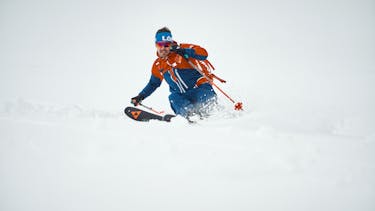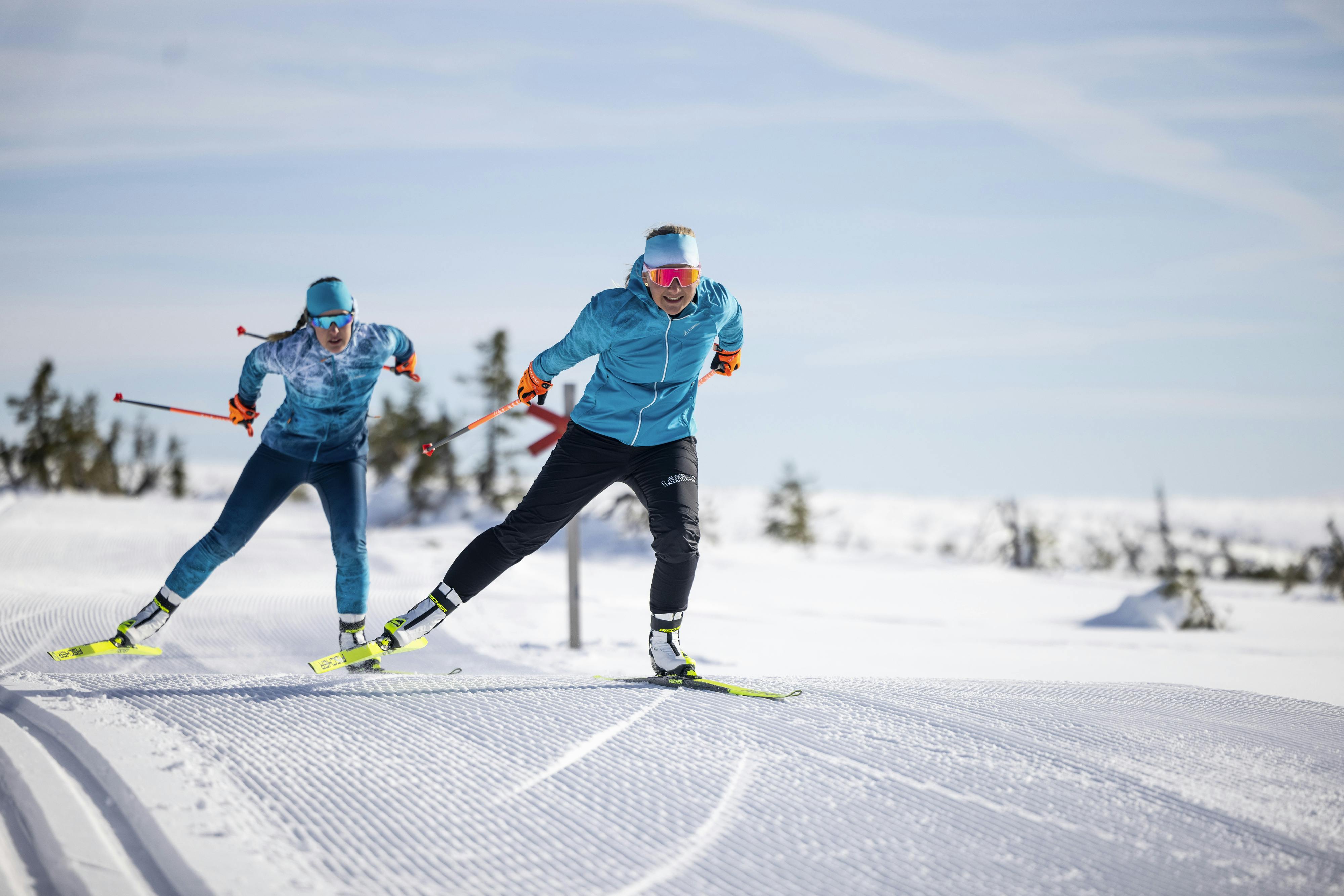Best length for ski poles? It depends on their use!
First of all: As with the selection of the ski, the choice of ski poles also depends on their usage. Freeriders need a different pole length than racers. The reason is quite simple and can be watched annually on sports channels: In order to get a good acceleration at the start of the giant slalom, a longer pole is recommended - the longer lever improves the power. On the other hand, when driving on mogul slopes, shorter poles are more likely to be used, as this allows the skier to move more dynamic. Before we explain how to calculate the ski pole length, we will give you an overview of the fields of application – after all, this is essentially related to your choice of size.
Alpine ski poles
Especially on the slopes, alpine ski poles should offer a pleasant effect adapted to the skiing style. These poles are mainly used to balance during the descent. Ski poles can also be very helpful when timing short turns while skiing.
For skiing at faster speeds, slightly longer poles are beneficial - they allow good thrust using the arms. Often you will notice very light ski poles such as the RD-16 featuring curved shafts in racing equipment. These were especially developed for thrusting using the arms.
Ski poles for kids
Ski poles for kids are not only shorter, they also differ in other aspects. The pole is usually thinner and the grips are narrower, so that delicate little hands have a good grip on their poles. The right time to buy ski poles for a kid depends entirely on the skills of the young skier. If the kid has internalized the essential skiing movements and already developed the necessary motor skills, such as using the ski lift with poles, it should be ready to have its own poles. The RD JR is an example for ski poles that can be used by kids.
Touring ski poles & the ideal ski pole length for freeriders
Most touring ski poles are telescopic poles, which makes their size individually adjustable to the respective slope inclination. Many prefer a longer shaft for a more convenient ascent uphill. If you need empty hands for using ice axes, telescopic poles will come in handy, as they can be easily reduced in size and attached to the backpack. Downhill, shortening the shaft will also be beneficial. Freeriders tend towards telescopic poles as well, since they are ideal for riding on moguls, half-pipes and in deep snow.

Getting the length for ski poles: Two ways to find out
Your body size is crucial for calculating the ski pole length. There are two ways to determine the right length - one is of theoretical nature, the other is based on practical testing.
1. Calculating the ski pole length by formula
Not only Pythagoras knew that formulas could be very useful in making life easier; ski racers also adhere to a mathematical formula when determining the length of their ski poles:
Body size in cm x 0.7 = ski pole length in cm
No calculator at hand? The following table is an overview of the available ski pole lengths on the market and their users respective body size:
| Body size | Length of ski pole |
|---|---|
| 99 - 105 cm | 70 cm |
| 106 - 112 cm | 75 cm |
| 113 - 119 cm | 80 cm |
| 120 - 126 cm | 85 cm |
| 127 - 133 cm | 90 cm |
| 134 - 140 cm | 95 cm |
| 141 - 147 cm | 100 cm |
| 148 - 154 cm | 105 cm |
| 155 - 161 cm | 110 cm |
| 162 - 168 cm | 115 cm |
| 169 - 175 cm | 120 cm |
| 176 - 182 cm | 125 cm |
| 183 - 189 cm | 130 cm |
| 190 - 196 cm | 135 cm |
| above 197 cm | 140 cm |
The formula's results shouldn't be set in stone, since there are also individual aspects at play: upper body length, leg length, skiing style and personal preferences of the skier. However, the result can serve as a first orientation. A practical test will reveal further information about the perfect pole length.
Freeriders may deduct approx. 5 cm from the recommended pole length! If the poles are used exclusively at the park, then very short models often are used: 1-meter ski poles are standard equipment for a freestyler.
2. Practical test for the right ski pole length
If you want to check the length, you should do the test wearing your ski boots and skis. Turn the ski pole upside down with the grip touching the ground. Grab the pole below the basket and hold it in front of your upper body. The part above the basket is not needed for this method as it will be dug into the snow when used and therefore is not taken into account for the pole’s length.
If your upper arm forms a right angle with your forearm, the pole has got the right length for you. Alternatively, you can just judge by your forearm: if it is horizontal to the ground while meeting the before mentioned conditions, then you found the ideal length.
-> Expert advice: Give the shorter or longer models a try as well, you'll find out how much difference a few centimetres can make!

Characteristics of ski poles:
If you think that buying ski poles is all about size, we’ve got to disappoint you. As mentioned before, there is a suitable model for every application. Once you found the right ski pole size, you will have to make your next purchase decision. For example, racing poles for speed are ergonomically shaped.
The material: Aluminium, Carbon
Different materials have a huge impact on a ski pole’s weight. Good ski poles feature an ergonomically shaped grip fitting completely into the hand. The straps guarantee that poles won’t get dropped on ground easily, taking a trip downhill without you.
The pole's material should be sturdy and lightweight - which many poles combine. High stability is important, especially in races where collisions and accidents better not affect the poles. Should the ski pole end up bent, you can try to warm it up by rubbing it with your gloves and then bend it. This way the pole can sometimes be restored to its original shape.
Simpler ski poles are made of aluminium and suffice for skiing down slopes. If you fall, it can happen that a pole gets twisted. However, you can get yourself poles made of heat-treated aluminium - these are stronger and more flexible. Many professionals use carbon poles due to their little weight and high stiffness.
Conclusion: Depending on the skiing style and pole use, the model should be chosen larger or smaller. Often, it's just a matter of personal preference. Therefore, the formula for calculating ski poles should just serve as an initial orientation. The practical test will show which length actually would serve you best - considering your personal skiing style, of course!



